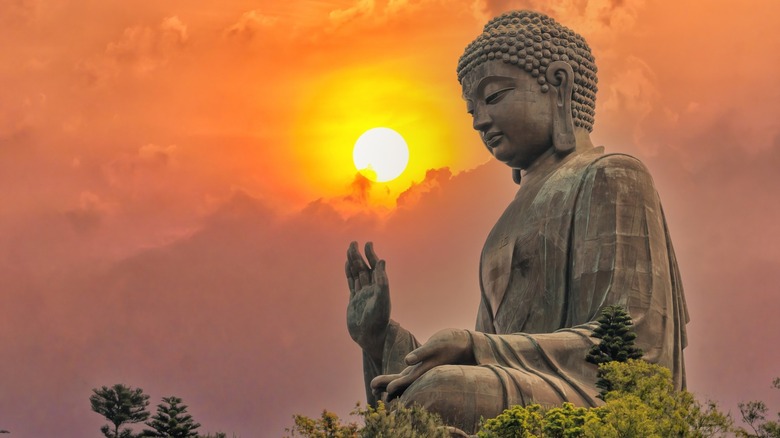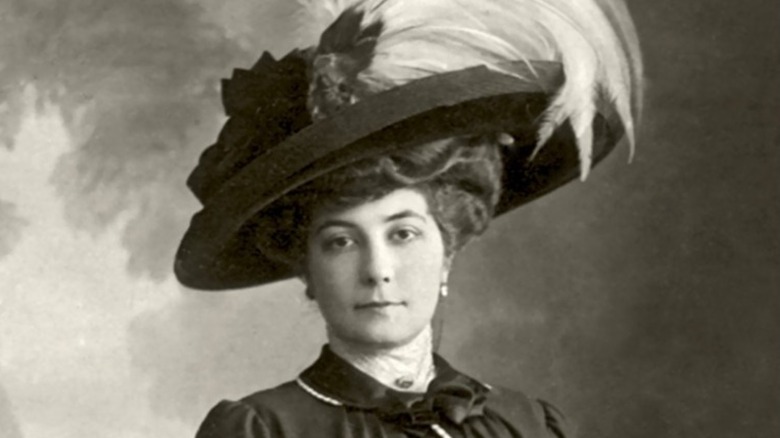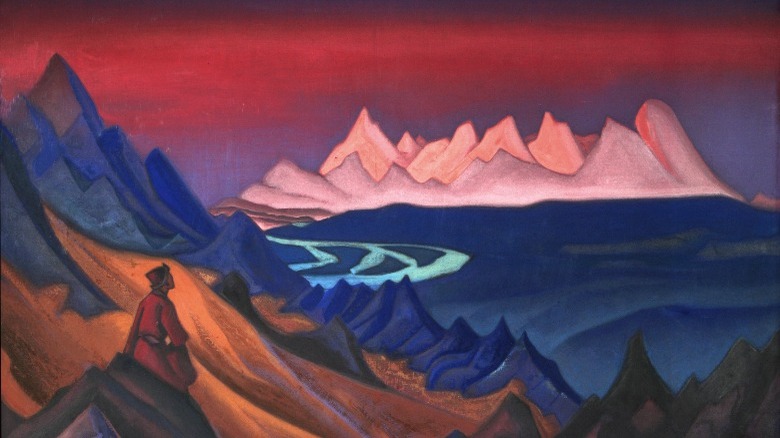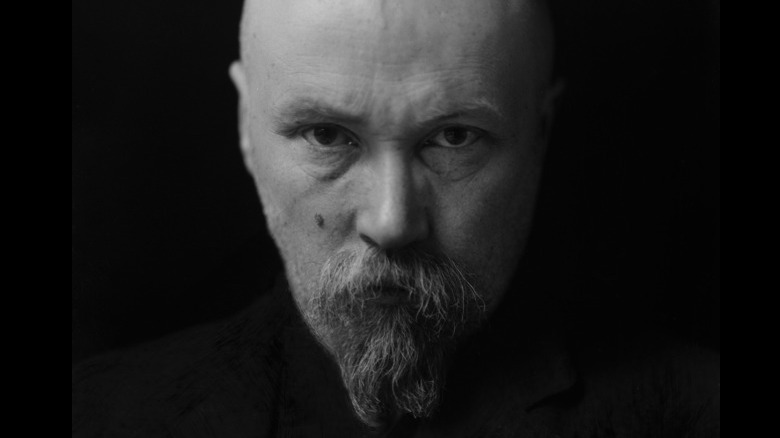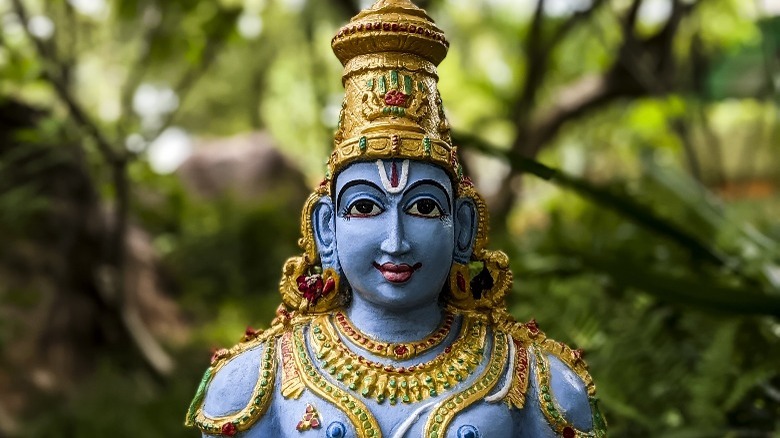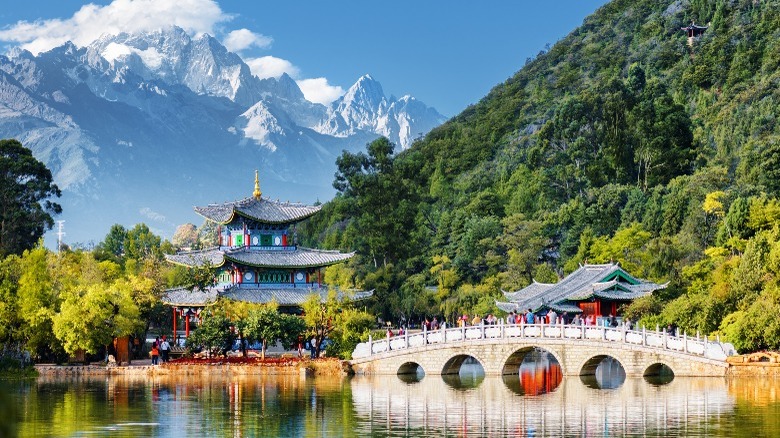Inside The Story Behind Shambhala, The Buddhist Kingdom That Was Never Discovered
It may be part of human nature to imagine there's a place out there free from strife and full of knowledge. Certainly, more than one culture has this concept. One such place is the kingdom of Shambhala in Hindu and Buddhist mythology. "Shambhala" comes from Sanskrit and means "place of peace" or "place of silence" (via IndiaDivine.org). This myth dates back more than a thousand years and varies depending on the source. However, Buddhists and Hindus agree that Shambhala is both a physical and a spiritual place (via Atlas Obscura). There is debate on where the physical Shambhala is located, but according to ThoughtCo., it is between the Himalayan mountains and the Gobi Desert. All the citizens of Shambhala have achieved enlightenment, so it represents a Buddhist ideal.
The tantalizing myth of Shambhala has led quite a few people into the Himalayas to try to find it. It has attracted the attention of everyone from hippies and spiritualists to Christian missionaries to the Nazis and Soviets.
Who went looking for Shambhala?
In the 1920s, a Russian couple, Nicholas and Helena Roerich, made one such expedition. They had escaped Russia just before the revolution of 1917 and were living in the United States. Helena Roerich (pictured) had translated "The Secret Doctrine" by Helena Blavatsky, a Russian spiritualist (via Atlas Obscura). The book mentioned Shambhala, claiming that finding it was a shortcut to enlightenment. The Roerichs began to seriously believe in Shambhala, and Helena Roerich claimed to have received a message from an otherworldly being telling her to go there.
The Roerichs ended up at the center of an international power struggle. At the time, Tibet was closed to the outside world, but several countries were vying for control of it, particularly the Soviet Union and Great Britain. These two powers (and others) were interested in the Shambhala myth, mostly as a possible propaganda tool to help them gain control of the region. However, the head of the Soviet secret police, Gleb Bokii, truly believed in Shambhala and a related Tibetan prophecy that said Shambhala's king would defeat an evil ruler to save humanity. Bokii thought if he found Shambhala, he would also learn how to control people's minds. He couldn't convince his superiors to fund a mission to look for Shambhala, so he decided to ally with the Roerichs. He offered them money in exchange for info about Shambhala — and about French and British spies in Tibet. Although the Roerichs distrusted the Soviets, they agreed (via Atlas Obscura).
What did the Roerichs encounter in Tibet?
According to Atlas Obscura, the Roerichs and their entourage arrived in Darjeeling, India, in December 1923. This included their son George, who was a multilingual Tibetologist and military strategist. Nicholas Roerich was a painter and an archaeologist, so the group told Indian authorities they wanted to make an archaeological excursion into Tibet. Because the Roerichs were well-known in the art world — and had American sponsorship on top of their secret Soviet sponsorship — they were ultimately allowed to go into Tibet.
They planned to cover about 25,000 kilometers, going through 35 mountain passes and across the Gobi Desert (via Atlas Obscura). There were many obstacles: They encountered blocked paths, extreme weather (including snowstorms), and criminal activity, such as local rebel groups and robbers. At times, they ran out of food. Still, the expedition continued for three years. As they traveled, they kept diaries, and Nicholas Roerich painted pictures of things they saw (example above), as well as pictures of the mythical king of Shambhala. He was also writing a book as they went called "Shambhala the Resplendent." In the book, he documented strange phenomena they encountered, like visions and unusual lights. However, these weren't mentioned in his travel diaries. In 1926, they made a detour to visit Moscow, but the Soviets refused to give them any more funding, so they returned to Tibet. The following summer, they disappeared.
What happened to the Roerichs?
The Roerichs' disappearance was extraordinary because their mission was still being monitored by several different countries (via Atlas Obscura). They were presumed to have died, but they reappeared a year later. The only information about this time period comes from Nicholas Roerich's travel diary, which described violent encounters with Tibetan forces. For the last five months that they were missing, they were being detained in a Tibetan government prison, where five members of the expedition died. After (presumably) being released, the rest of them returned to India.
According to Nicholas Roerich's diary, the group had at least found the entrance to Shambhala. It was in the Uimon Valley in the Altai Mountains. An "Old Believer" showed them that the kingdom was underground and its entrance had been closed off with stones. He told them the people of Shambhala would return one day. The Roerichs returned to the region in 1933, exploring Manchuria and continuing to look for Shambhala. The expedition was scientifically and archeologically important, but Shambhala remained elusive. The Roerichs became well-known — Nicholas (pictured) was nominated three times for the Nobel Peace Prize, and they had a planet named for them — but never found their lost kingdom.
Who is Kalki in the Shambhala myth?
Shambhala is significant to Hindus as well as Buddhists because ancient Hindu texts say it's the birthplace of Kalki, the final incarnation of Vishnu, the preserver of the world (via IndiaDivine.org). According to Study Buddhism, Kalki is prophesied to defeat an invading army and usher in a golden age.
Buddhist texts, on the other hand, talk about a line of kings that will take the name Kalki in honor of Vishnu. The first of these kings will unite India's castes. Later, the 25th Kalki leader (or 32nd in some versions of the story) will defeat invaders. The previous unification of the castes will be key to taking on the invading forces. Again, defeating these forces will be the beginning of a golden age (via Study Buddhism).
According to ThoughtCo., another version of this myth says that the 25th Kalki king will reign around A.D. 2400, at which point the world will be in chaos, and the king will have to defeat darkness instead of an army. He will succeed, and this will lead to peace. In this version, the king is a messianic figure.
Are Shambhala and Shangri-La the same thing?
The BBC and others have noted the similarities of stories about Shambhala and the mystical land of Shangri-La from the 1933 book "Lost Horizon" by James Hilton. Shangri-La is described as a spiritual community in Tibet based around a lamasery (a monastery for Buddhist lamas). It is set apart from the real world both spatially and temporally and is said to hold all the world's wisdom. The similarity in location, mysticism, and name has led people to draw a connection between the two places.
Hilton may have been partially inspired by the account of Antonio Andrade, a Portuguese Jesuit missionary who wrote about discovering a wealthy kingdom in Tibet. Though written hundreds of years earlier, it was republished in 1926, only seven years before the publication of "Lost Horizon" (via BBC). Elsewhere, both ThoughtCo. and IndiaDivine.org list Shangri-La as an alternate name to Shambhala. IndiaDivine.org says both names come from Sanskrit. They note many other names for this mysterious place, including the Forbidden Land, the Land of the Living Gods, and the Land of Radiant Spirits. The Russians and the Chinese also have their own names for it. More simply, this land of enlightenment can be called paradise.
